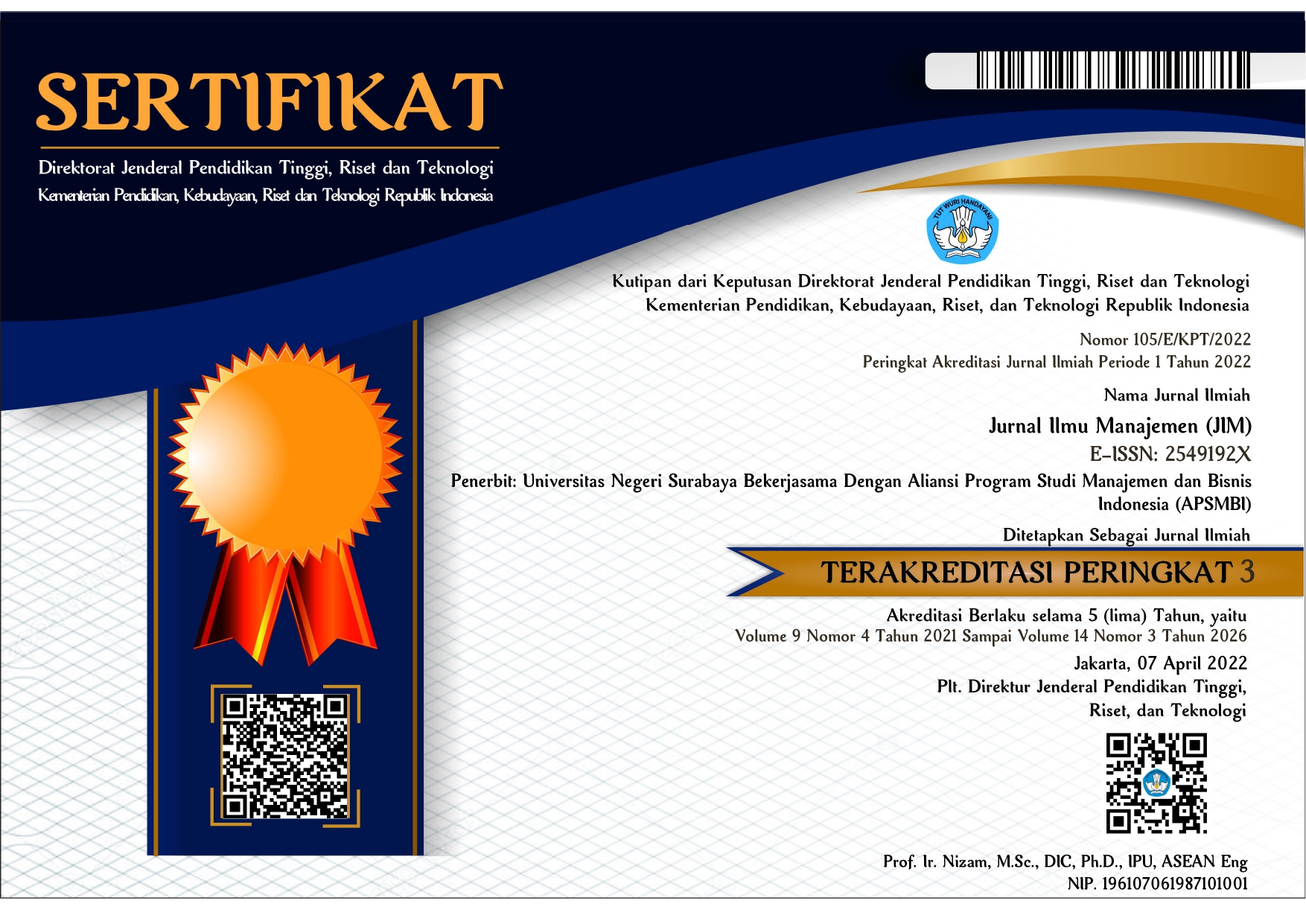Pengaruh human resource information system terhadap employee performance dengan employee engagement sebagai variabel moderasi
DOI:
https://doi.org/10.26740/jim.v12n1.p169-183Keywords:
Employee Engagement, Employee Performance, Human Resource Information System, UTAUT ModelsAbstract
This study aims to determine and analyze the effect of implementing a human resource information system on employee performance with employee engagement as a moderating variable at an outsourcing company. This research is an explanatory type of research that uses a quantitative approach with a population of 54 internal employees. The sampling technique used is a saturated sample with a sample size of 54 internal employees. The statistical analysis method in this study is Partial Least Square, which is supported by SmartPLS 4.1.0.0 computer software. The result of this study indicates that performance expectancy has a significant effect on employee performance, effort expectancy has a significant effect on employee performance, social influence has no significant effect on employee performance, and facilitating conditions have a substantial impact on employee performance. Employee engagement can’t moderate the relationship between performance expectancy and employee performance; employee engagement can’t moderate the relationship between effort expectancy and employee performance; employee engagement can’t moderate the relationship between social influence and employee performance; employee engagement can’t moderate the relationship between facilitating condition on employee performance. Companies that implement human resource information systems in their work are expected to pay attention to performance expectancy, effort expectancy, and facilitating conditions from human resource information systems because applying them can improve employee performance.
References
Anindita. (2021). Pengertian & Fungsi HRM Software. BusinessTech Hashmicro.
Armstrong, M. and S. T. (2012). The handbook of human resource management. In The SAGE Handbook of Human Resource Management (12th ed.). Ashford Colour Press. https://doi.org/10.4135/9780857021496
Development, C. I. of P. and. (2012). Employee Engagement Factsheet. www.cipd.co.uk/hr-resource/factsheets/employee-engagement.aspx
Garson, G. D. (2016). Partial Least Square: Regression & Structural Equation Models. Statistical Publishing Associates.
Ghozali, I. (2018). Aplikasi Analisis Multivariate dengan Program IBM SPSS 25. Badan Penerbit Universitas Diponegoro.
Hasibuan. (2019). Manajemen Sumber Daya Manusia (23rd ed.). Bumi Aksara.
Kompaso, S. M., & Sridevi, M. . (2010). Employee Engagement: The Key to Improving Performance. International Journal of Business & Management, 5(12), 89. https://doi.org/10.5539/ijbm.v5n12p89
Lewiuci, P. G., & Mastamu, R. H. (2016). Pengaruh Employee Engagement terhadap Kinerja Karyawan pada Perusahaan Keluarga Produsen Senapan Angin. Agora, 4(2). https://publication.petra.ac.id/index.php/manajemen-bisnis/article/view/4738/4348
Lutfi, E. (2023). Sistem HRIS: Manfaat dan Pentingnya bagi Perusahaan. Insight Talenta. https://www.talenta.co/blog/manfaat-sistem-hris-adalah-untuk-kelola-perusahaan-lebih-mudah/
Mangkunegara, A. P. (2017). Manajemen Sumber Daya Manusia Perusahaan (14th ed.). PT. Remaja Rosdakarya.
McLeod, R. (2012). Sistem informasi manajemen (10th ed.). Jakarta : Salemba Empat.
Moeheriono. (2012). Pengukuran kinerja berbasis kompetensi (revisi). Jakarta : RajaGrafindo Persada.
Rahadi, D. R. (2023). PENGANTAR PARTIAL LEAST SQUARES STRUCTURAL EQUATION MODELING (PLS-SEM). CV. Lentera Ilmu Madani.
Robbins, S. P., & Judge, T. A. (2015). Organizational Behavior (16th ed.). Vital Source (for Pearson) VST.
Robinson, D., Perryman, S., & Hayfield, S. (2004). The Drivers of Employee Engagement. Institute for Employment Studies.
Sitinjak, W., Anugrah, R., Andary, R. W., Sungkawati, E., & Badrianto, Y. (2020). Kinerja Karyawan (Hartini (ed.)). Media Sains Indonesia.
Venkatesh, V., Morris, M. G., Davis, G. B., & Davis, F. B. (2003). User acceptance of information technology: Toward a unified view1. MIS Quarterly, 27(3), 425. https://doi.org/10.2307/30036540
Veronica, H.-H., Searle, D. R., & Dietz, D. G. (2012). Where has all the trust gone? In CIPD Research Report: Vol. March. http://www.cipd.co.uk/binaries/where-has-all-the-trust-gone_2012-sop.pdf
Downloads
Published
How to Cite
Issue
Section
License

This work is licensed under a Creative Commons Attribution-NonCommercial 4.0 International License.
 Abstract views: 1568
,
Abstract views: 1568
, PDF Downloads: 637
PDF Downloads: 637










